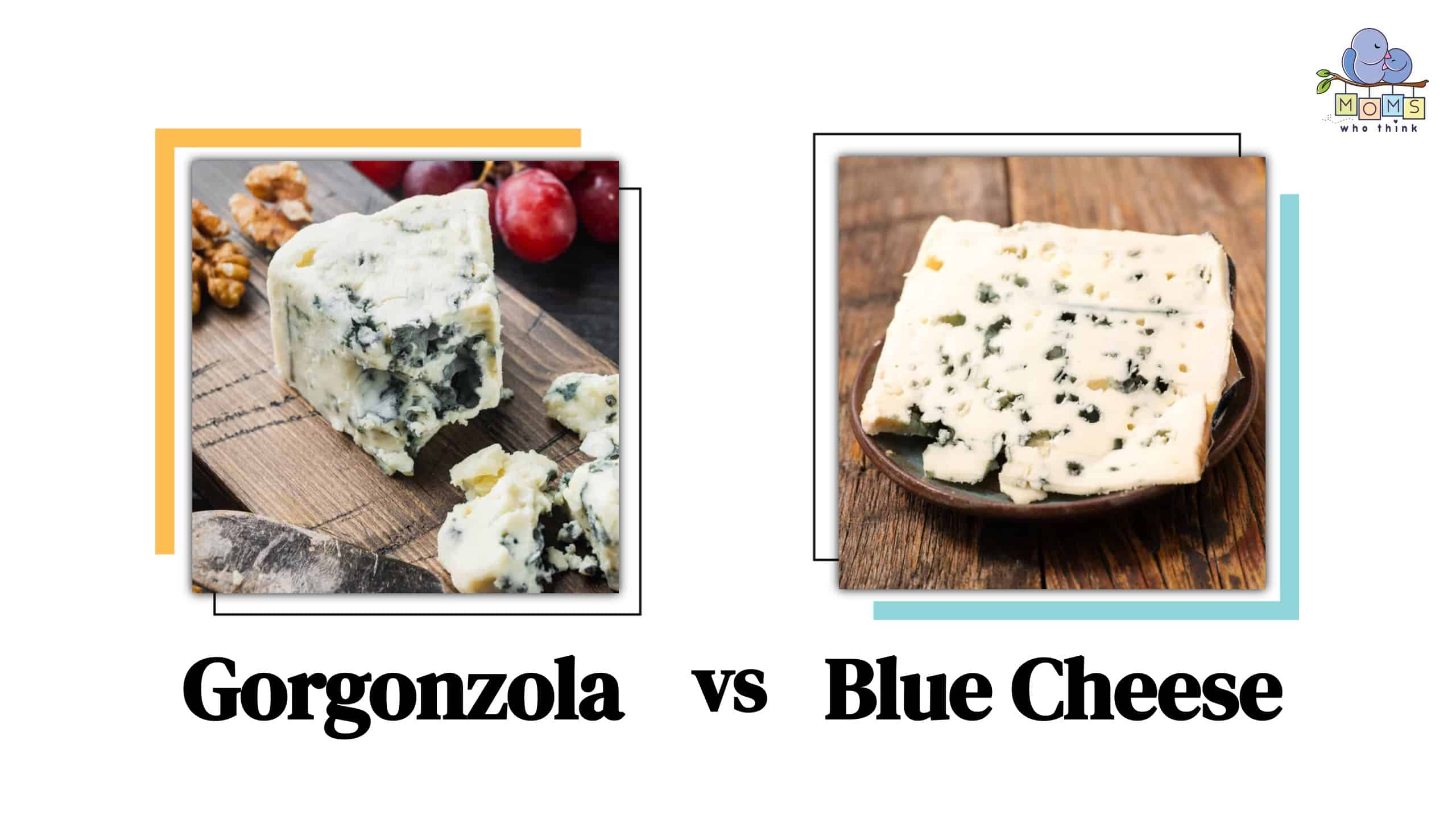Have you ever noticed gorgonzola next to blue cheese in the grocery store and wondered how these two cheeses can be different when they look almost identical? While gorgonzola and blue cheese may look similar, they differ in taste, texture, and flavor.
In this post, we'll dig into the differences between gorgonzola and blue cheese, including how you can use each cheese to add depth and flavor to your busy weeknight meals or weekend get-togethers. Whether you're looking to create a savory pasta dish or add a unique twist to your salads, we've got you covered with our in-depth comparison of gorgonzola and blue cheese.
Gorgonzola vs. Blue Cheese: What Is the Difference?
Gorgonzola and blue cheese are both types of mold-ripened cheeses, but there are important differences. Gorgonzola is a specific type of blue cheese made with cow's milk and has a softer, milder flavor compared to other blue cheeses. On the other hand, blue cheese is a broader category of cheeses that can be made with different types of milk, such as cow, goat, or sheep. While there's a large variety of blue cheeses, young gorgonzola (aged 4 months or less) is a favorite for those looking for milder flavors.
What is Gorgonzola?
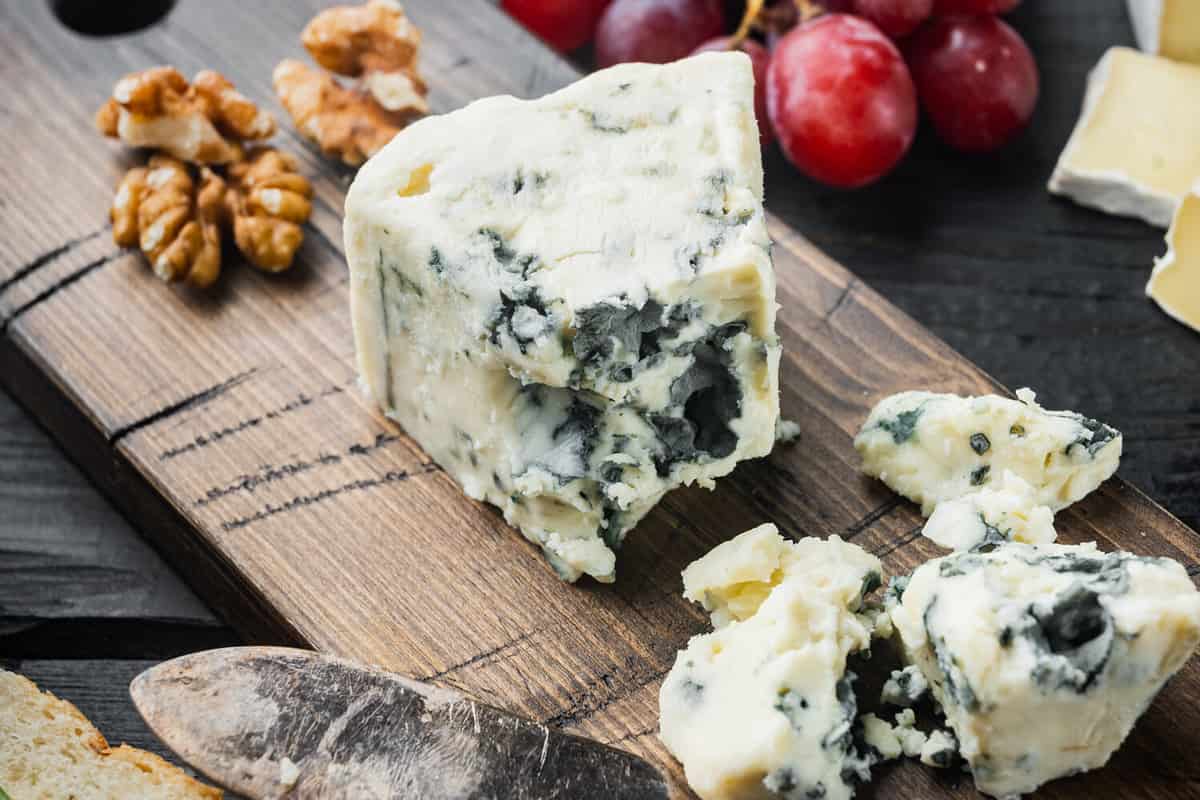
©Chatham172/Shutterstock.com
Gorgonzola, a specific type of blue cheese, is known for its white color on the outside and blue-green streaks on the inside. It has a unique aging process and is known for its use in Italian cuisine.
Origin
Gorgonzola is uniquely named after the town of Gorgonzola, Italy, where it was first made in the 11th century. The Northern Italy region still famously makes this cheese today, but it's also produced worldwide.
Characteristics and Texture
Gorgonzola is made from unskimmed cow's milk and is aged with a Penicillium fungus, which gives it its distinctive blue-green veins. Because this cheese is not pressed in the production process, it has a very creamy, moist texture that can range from soft to crumbly, depending on the age of the cheese.
Additionally, there are two types of gorgonzola: Gorgonzola dolce, which is young and creamy, and gorgonzola piccante, which is aged for longer and has a stronger and sharper flavor.
Flavor
The flavor of gorgonzola is tangy, pungent, and very distinct, though it tends to be a bit milder than regular blue cheese. The flavor will also depend on the type of gorgonzola cheese made – dolce or piccante – and how long it's aged.
Production
As mentioned, gorgonzola is made of pasteurized cow's milk. The milk is heated and combined with a starter culture and rennet, which causes the milk to curdle. The curds are then placed in a mold and metal rods are inserted to create holes that allow for air to circulate. As the mold grows, it gives the cheese its signature blue-green streaks.
At this point, the cheese is left to age anywhere from a few months, up to a year. During the aging process, the cheese is usually stored in a cool, humid environment, where the blue mold can grow and spread throughout the cheese. The aging time for gorgonzola can vary depending on the desired flavor and texture.
Popular Uses
Gorgonzola is often used in Italian cuisine, where it's added to pasta dishes, risotto, pizzas, and salads. It can also be served on a cheese board or used to create different types of sauces or toppings.
Nutritional Value
When looking at the nutritional value of gorgonzola cheese, we can see that it's a good source of calcium, protein, and vitamins A and D. However, it is also high in fat and calories, so it should be consumed in moderation.
What is Blue Cheese?
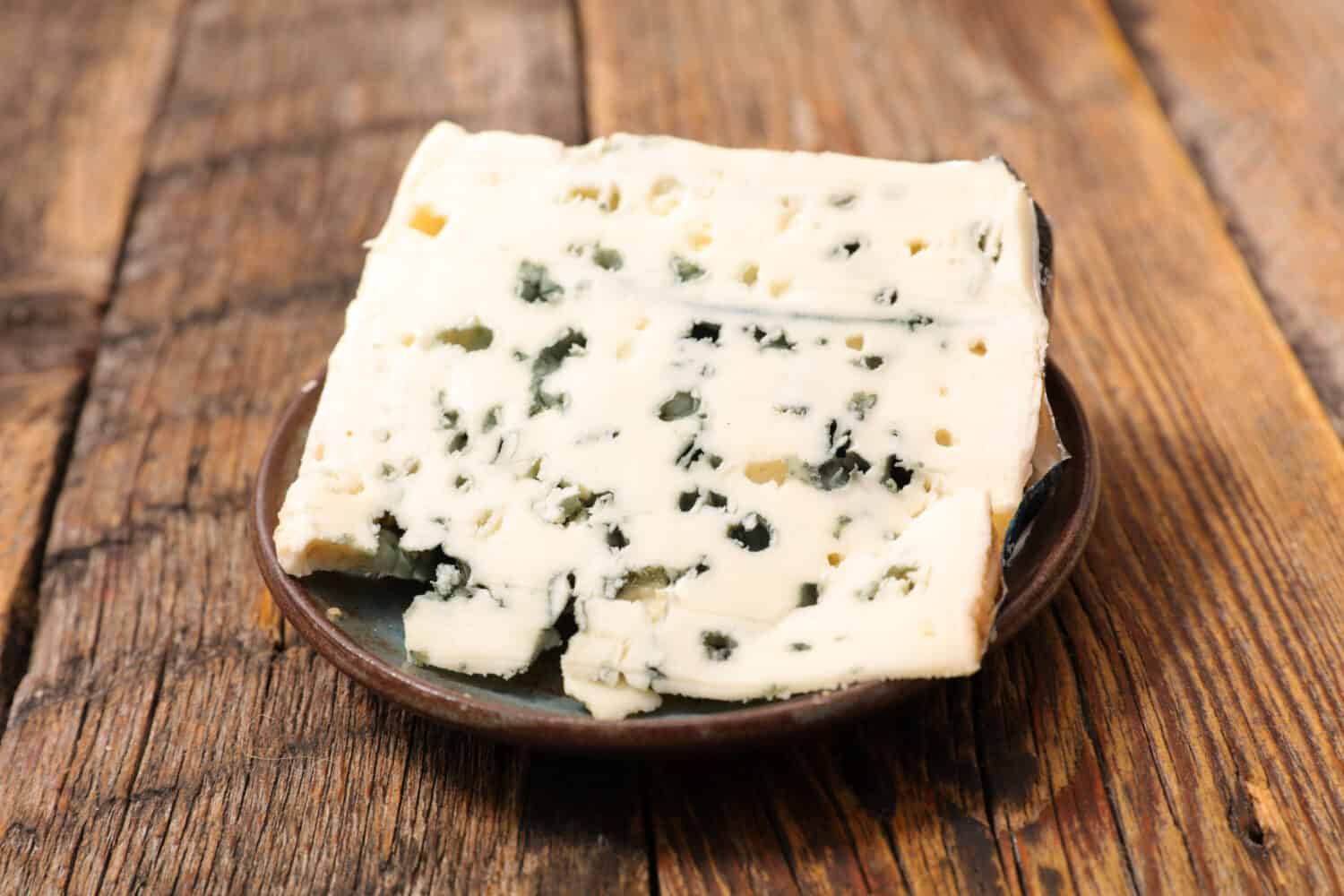
©Chatham172/Shutterstock.com
Similar to gorgonzola, blue cheese is known for its distinctive blue veins. However, unlike gorgonzola which is made from only cow's milk, blue cheese can be made from cow's, sheep's, or goat's milk, and then aged for several weeks or months.
Origin
While the origin of blue cheese isn't entirely clear, stories dating back to the 11th century suggest blue cheese was discovered by accident after the cheese was left in a cave where penicillium mold was present. Today, blue cheese is most famously produced in France and Italy, but many different varieties of blue cheese are manufactured worldwide.
Characteristics and Texture
While gorgonzola is known for being white with signature blue-green streaks, blue cheese is off-white and can have streaks ranging from blue to blue-gray. The texture of blue cheese can vary depending on the type, but it is generally creamy or crumbly with a slightly grainy texture that comes from the blue veins.
Flavor
Most types of blue cheese tend to be sharp and salty, with gorgonzola being the exception as it tends to be a creamier version. Additionally, blue cheese comes with a strong smell from the mold used to produce it.
Production
The production of blue cheese is similar to gorgonzola. Pasteurized cow, goat, or sheep's milk is heated and combined with a rennet and starter culture to create curds. The solid curds are formed into a wheel, at which time penicillium is injected. Penicillium creates the molding process that gives blue cheese its famous color.
There are two types of penicillium that are used to make blue cheese: Penicillium glaucum and Penicillium roqueforti. Which type of blue cheese is being produced will determine which type of penicillium mold to use.
The cheese is then allowed to age over several months in a temperature-controlled environment.
Popular Uses
One of the best things about blue cheese is its versatility. Not only does it pair well with fruits, nuts, crackers, and bread, but it can also be used in salads, pasta, and pizza. Blue cheese is popular for the flavor and texture it can add to steak or burgers when crumbled on top, as well.
Nutritional Value
Blue cheese can provide several health benefits as it's a good source of protein, calcium, and vitamin B12. Like most cheeses, however, it's higher in fat and sodium, so it should be consumed in moderation.
Are Gorgonzola and Blue Cheese the Same Thing?
Because gorgonzola is a type of blue cheese, these two cheeses are often confused as being identical. It's important to note that while these two cheeses would make a great substitute for each other, they are technically not the same.
Gorgonzola is milder and only one type of blue cheese. In general, blue cheese is sharper, more pungent, and has several varieties, including:
- Roquefort, which is a French blue cheese made from sheep's milk.
- Stilton, an English blue cheese made from cow's milk.
- Danablu, a Danish blue cheese that's milder and also made from cow's milk.
Depending on your recipe and personal preference, you can normally use gorgonzola and blue cheese interchangeably without many issues. Just keep in mind that each cheese offers its own taste and texture.
Popular Substitutes for Gorgonzola and Blue Cheese
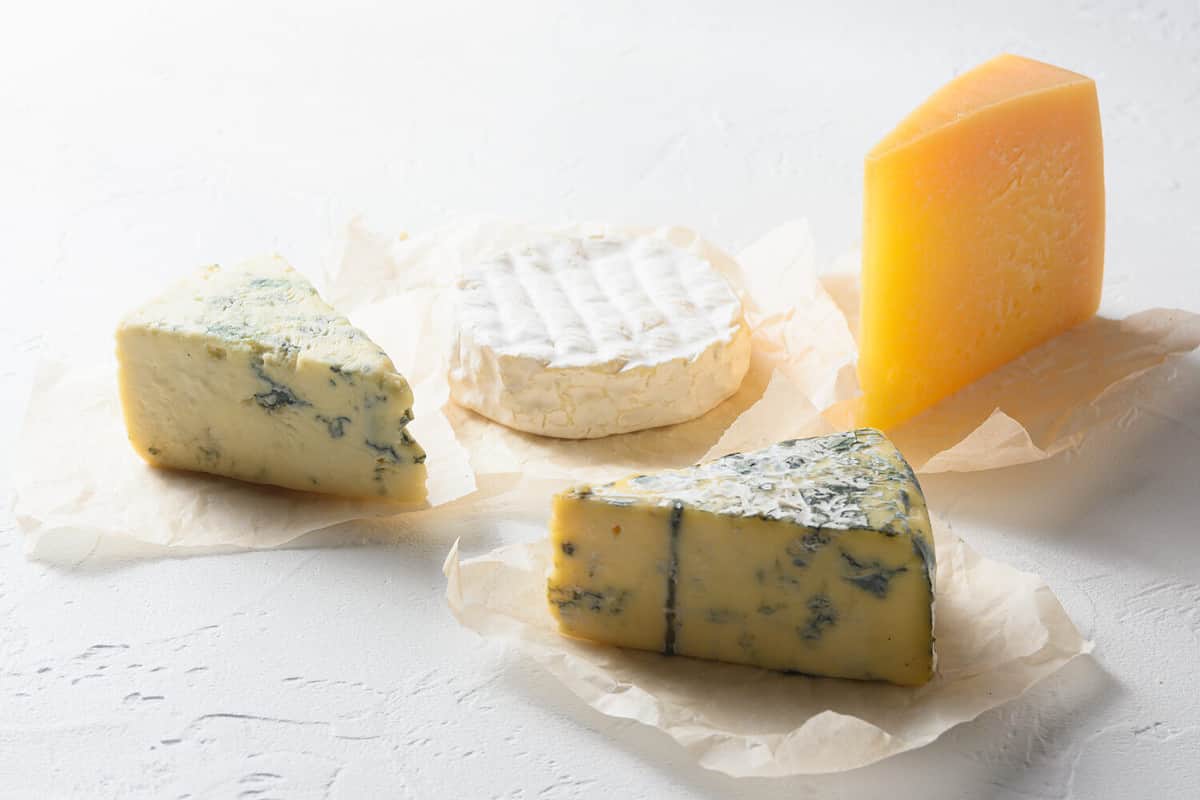
©Chatham172/Shutterstock.com
Blue cheese offers many different varieties, as mentioned above. However, if you're in a pinch or simply looking to try something different, here are a couple of other options that can work as substitutes:
Feta
Similar to blue cheese, feta is a soft, crumbly, white cheese, making it a good substitute in many dishes. It doesn't offer the same strong tangy and salty flavor as blue cheese, however, so keep that in mind when using it in your recipe.
Goat Cheese
Goat cheese is similar to blue cheese with a tangy flavor and creamy texture. The tanginess can make it an excellent substitute if you're in need of a replacement.
Gorgonzola Recipes
Blue Cheese Recipes
Print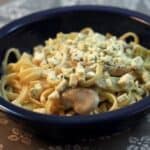
Blue Cheese Artichoke Fettuccine
- Yield: Serves 4
Ingredients
1 (9 ounce) package refrigerated fettuccine
Cooking spray
1 (14 ounce) can quartered artichoke hearts, drained
8 ounces sliced fresh mushrooms
1 (10 ounce) container refrigerated light alfredo sauce
2 tablespoons crumbled blue cheese
Instructions
1. Cook pasta according to package directions, omitting salt and fat.
2. Meanwhile, coat a large nonstick skillet with cooking spray; place over medium-high heat until hot. Add artichokes and mushrooms; cook 3 to 4 minutes or until mushrooms are tender.
3. Add alfredo sauce to artichoke mixture; cook until thoroughly heated.
4. Place drained pasta in a large bowl. Pour sauce mixture over pasta; toss to combine. Sprinkle with cheese.
Nutrition
- Serving Size: Per serving
- Calories: 313
- Sodium: 691mg
- Fat: 9g
- Saturated Fat: 4g
- Carbohydrates: 46g
- Fiber: 3g
- Protein: 15g
- Cholesterol: 25mg
Final Thoughts
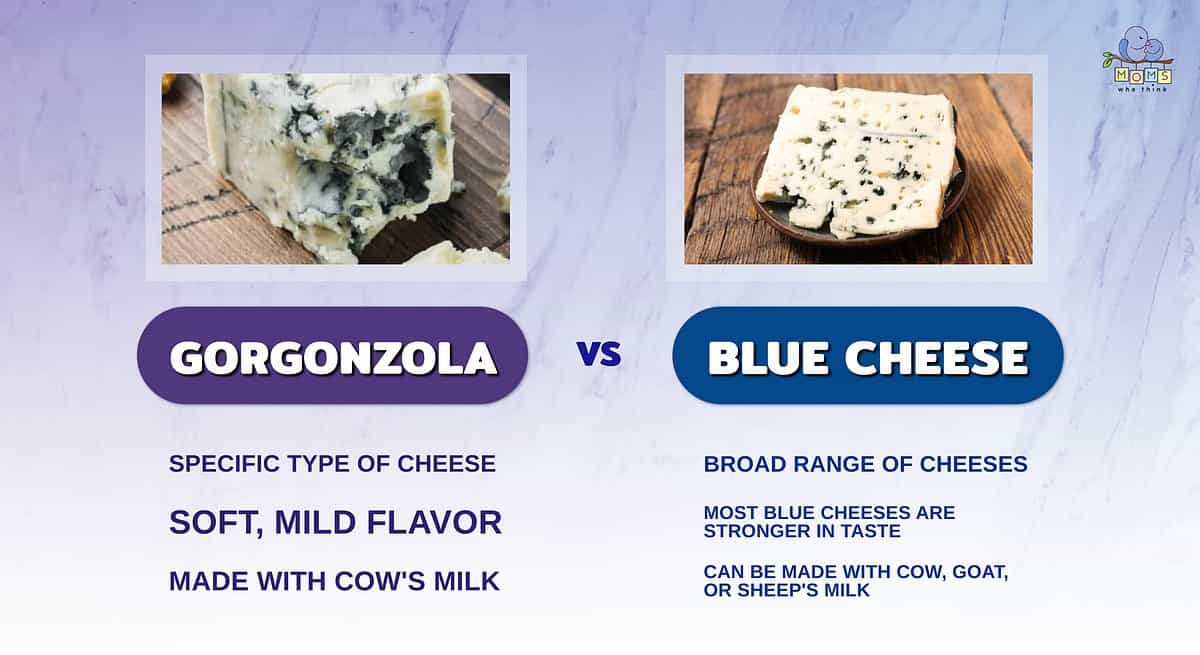
- Gorgonzola is a specific type of blue cheese. If you hear someone say “blue cheese”, they could be referring to any one of a number of different cheeses.
- Blue cheese can have a range of flavors depending on the variety you're considering, but most are stronger in flavor than gorgonzola.
- Gorgonzola is always made with cow's milk, while other blue cheeses can be made with cow, goat, or sheep's milk.
Both gorgonzola and blue cheese are popular cheeses with a rich history. Although they seem similar and look almost identical, they differ in flavor and texture. Gorgonzola is creamy and mild while blue cheese is strong and tangy. Gorgonzola is also a type of blue cheese, making it a great substitute if you're in a pinch.
Ultimately, the choice of which cheese to use comes down to personal preference. Either option is a great choice for your next meal.
